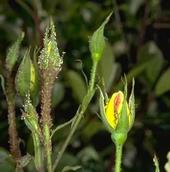
The recent warm spring weather has stimulated aphid outbreaks in many landscapes and gardens. Two short YouTube videos from the University of California Statewide IPM Program show how to battle these pests without pesticides.
Hosing Off Aphids demonstrates techniques for knocking off aphids with water.
In Aphid-eating Insects in Action see lady beetles, syrphid flies, lacewings and other "natural enemies" hunting and gobbling up aphids.
UC IPM provides much more aphid management and identification information on its web pages at
- Author: Mary Louise Flint
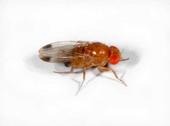
[From March 2013 issue of the Retail Nursery and Garden Center IPM News.]
Spotted winged drosophila (SWD), Drosophila suzukii, is a fruit fly that first arrived in California in the late 2000s and now is present throughout most of the state (Figure 1). It can attack various berry crops including strawberries, raspberries, blackberries, and blueberries; however, in backyards most complaints come from gardeners who grow cherries.
Unlike other fruit flies that attack fruit only after it has ripened and is starting to deteriorate, SWD attacks healthy fruit on the tree...
- Author: Steven Swain
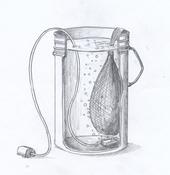
[From the August 2013 issue of the UC IPM Green Bulletin newsletter]
What is compost tea? Is it a good nutrient source? Can it suppress plant disease?
The fundamentals of compost tea are very simple: it's merely compost suspended in a porous bag (like cheesecloth) and soaked in water. If the compost was of good quality, then the water typically takes on a dark, blackish color (appearing a lot like a strong black tea). However, compost tea quality depends on the quality of the parent compost, and compost can vary quite a bit in its makeup, depending upon...
- Author: Karey Windbiel-Rojas
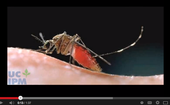
Do you know how to check your hotel room for bed bugs before you settle in for the night? Can you tell the difference between yellowjackets, paper wasps, and other common wasps? What's in that bottle of pesticide you are thinking of using on your plants? New videos from UC IPM can help answer these questions!
Thanks in part to funding from the Western IPM Center, the UC Statewide Integrated Pest Management Program has recently created a series of short, 2-3 minutes videos to help you identify, monitor, manage or prevent some pests from becoming problems around your home and garden!
Find out how to use a bed bug detector (see video below) and how to inspect your bedroom or hotel room for bed bugs. Protect yourself from...
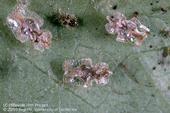
Lace bugs are small, sculptured insects with lacey wings. They suck sap from plants causing leaf stippling and bleaching, and they often foul leaves with specks of dark excrement. Several dozen species may occur in the western U.S. Landscape plants commonly affected include alder, ash, avocado, azalea, ceanothus, cotoneaster, coyote bush, photinia and toyon.
Most plants are not seriously damaged, and natural enemies and good cultural practices can often reduce lace bug populations. However, when insecticides are needed, there are several products that work well as part of an integrated pest management program that reduces risks to pollinators, other beneficial insects, and the environment. Learn more about how to...


